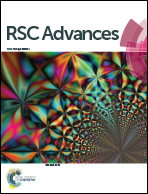Effects of V2O5 nanowires on the performances of Li2MnSiO4 as a cathode material for lithium-ion batteries†
Abstract
The effects of vanadium pentoxide on the electrochemical properties of Li2MnSiO4 as a cathode material for lithium-ion batteries were tested by synthesizing a V2O5 nanowire-modified in situ carbon coated Li2MnSiO4 composite (LMS/C/V2O5) and comparing its performances with that of a Li2MnSiO4 composite without V2O5. In LMS/C/V2O5, the V2O5 nanowires, with diameters of around 10–20 nm and lengths up to tens of micrometers, entangled together and formed a 3D conductive network; the Li2MnSiO4 nanoparticles, with sizes around 30 nm, distributed uniformly in the network frame and tended to adhere to the V2O5 nanowires. In this structure, the LMS/C/V2O5 composite showed a superior performance as a cathode of lithium-ion batteries even with very low carbon content (3.4 wt%). Ex situ X-ray diffraction patterns, electrochemical impedance spectroscopies of the electrodes and the concentration of Mn ions in the electrolyte during the charge–discharge processes explained the effects of the V2O5 nanowires as an additive in the Li2MnSiO4 cathode material. The benefits of the nanowires include maintaining the crystal structure of Li2MnSiO4 during the charge–discharge cyclings, reducing the charge-transfer resistances at the solid–electrolyte interfaces, increasing the lithium ions diffusion coefficient in the cathode and alleviating the dissolution of manganese into the electrolyte of the batteries.


 Please wait while we load your content...
Please wait while we load your content...